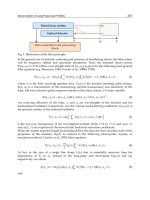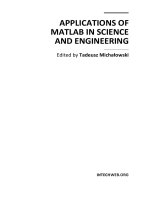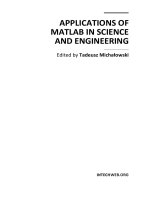MATHEMATICAL METHOD IN SCIENCE AND ENGINEERING Episode 17 doc
Bạn đang xem bản rút gọn của tài liệu. Xem và tải ngay bản đầy đủ của tài liệu tại đây (3.09 MB, 40 trang )
TIME-INDEPENDENT GREENS FUNCTIONS
593
with the initial conditions
z(0)
=
k(0)
=
0,
C1
and
C2
in Equation
(19.147) is zero, hence the solution will be written as
where we have defined
(19.156)
One can easily check that
s(t)
satisfies the differential equation
d'z(t) dz(t)
2
dt2
+
2E-
+
woz(t)
=
&-at.
dt
(19.157)
For
weak damping the solution reduces to
As
expected, in the
t
+
00
limit this becomes
FO
sin
[wot
-
71
z(t)
=
-
wo
JW'
19.1.12
Green's Function
for
the Helmholtz Equation in Three
Dimensions
The Helmholtz equation in three dimensions is given
as
We now look
for
a
Green's function satisfying
+
ko
G(?,
F')
=
S(7
-
7').
("'
2,
(19.159)
(19.160)
We multiply the first equation by
G(?,7')
and the second by
$(7)
and
then subtract, and integrate the result over the volume
V
to get
-
///v
F(?)G(7,
7')d3?;t.
(19.161)
594
GREEN’S
FUNCTIONS
Using Green’s theorem
JJJ,
(FV~G
-
GV~F)
d3F
=
JJ
(PVG
-
GVF)
.
iids,
(19.162)
S
where
S
is
a
closed surface enclosing the volume
V
with the outward unit
normal
ii,
we obtain
Interchanging the primed and the unprimed variables and assuming that the
Green’s function is symmetric in anticipation of the corresponding boundary
conditions to be imposed later, we obtain the following remarkable formula:
Boundary
conditions:
The most frequently used boundary conditions are:
i) Dirichlet boundary conditions, where
G
is
zero on the boundary.
ii) Neumann boundary conditions, where the normal gradient
of
G
on the
surface is zero:
TG.61
=O.
boundary
iii) General boundary conditions:
=
0,
boundary
TG
+
??(?“)GI
where
T(F’)
is
a
function
of
the boundary point
7‘.
surface term in the above equation vanishes, thus giving
For
any one
of
these cases, the Green’s function is symmetric and the
(19.165)
19.1.13
Green’s Functions in Three Dimensions with
a
Discrete
Spectrum
Consider the inhomogeneous equation
H@(?;’)
=
F(?;‘),
(19.166)
TIME-INDEPENDENT GREEN
5
FUNCTIONS
595
where
H
is
a
linear differential operator.
H
has
a
complete set of orthonormal
eigenfunctions,
{$A(?)),
which are determined by the eigenvalue equation
where
X
stands for the eigenvalues and the eigenfunctioris satisfy the homoge-
neous boundary conditions given in the previous section. We need
a
Green's
function satisfying the equation
HG(7,
?')
=
S(?
-
7').
(19.167)
Expanding
@(?)
and
F(?)
in terms of this complete set
of
eigenfunctions
we write
(19.168)
@(-i i>
=
Ex
axdx(?;')
F(?)
=
Ex
cx$x(?")
where the expansion coefficients
are
(19.169)
ax
=
JJj",
43?)@(?)d3?
cx
=
JJJ,
$1(?)F(?)d3?
(19.170)
ax
=
Using this
ax
and the explicit form
of
cx
in Elpation (19.169) we can write
Q(7)
as
CA
X
Substituting these into Equation (19.166) we obtain
This gives the Green's function
as
(19.172)
This Green's function can easily be generalized to the equation
(H
-A,)
@(?)
=
F(?),
(19.173)
for the operator
(H
-
A,)
as
(19.174)
596
GREENS
FUNCTlONS
We now find the Green’s function for the three-dimensional Helmholtz
equation
(“2
+
k;)
$(?)
=
F(?)
in
a
rectangular region bounded by
six
planes:
x=O,
z=a
y=O, y=b
z=o,
z=c
(19.175)
i
and with the homogeneous Dirichlet boundary conditions. The corresponding
eigenvalue equation is
T241mn(T)
+
k12,,4lmn(T)
=
0-
The normalized eigenfunctions
are
easily obtained
as
where the eigenvalues are
L2x2
m2x2
n2r2
klmn
=
-
+
-
+
-
a2
b2 c2
’
(1,
m,
n
=
positive integer). (19.177)
Using these eigenfunctions
[Eq.
(19.176)] we can now write the Green’s func-
tion
as
(19.178)
19.1.14
Green’s function for the Laplace operator
V2
satisfies
Green’s Function for the Laplace Operator Inside a Sphere
q2G(
7,
?’)
=
S(
?,
?’).
(19.179)
Using spherical polar coordinates this can be written
as
T2G(?,
7’)
=
~
S(r
-
r’)
S(cm
e
-
cos8’)6(4
-
4’)
(19.180)
r
’2
TIME-INDEPENDENT GREEN’S FUNCTIONS
597
where we have used the completeness relation of the spherical harmonics. For
the Green’s function inside
a
sphere, we use the boundary conditions
G(0,T’)
=
finite, (19.182)
G(u,
7’)
=
0.
(19.183)
In spherical polar coordinates we can separate the angular part and write the
Green’s function
as
(19.184)
1=0
m=-l
We now substitute Equation (19.184) into Equation (19.181) to find the dif-
ferential equation that
gl(r,
r’)
satisfies
as
1
gl(r,r’)
=
-6(r
-
r’).
r
‘2
1
d2
1(1+
1)
-
-
[Tgl
(T,
?-’)I
-
7
r
dr2
A
general solution of the homogeneous equation
can be obtained by trying
a
solution
as
~r‘
+
clr-(l+l).
(19.185)
(19.186)
(19.187)
We can now construct the radial part of the Green’s function for the inside of
a
sphere by finding the appropriate
u
and the
u
solutions
as
r
<
r‘,
r
>r’.
(19.188)
Now the complete Green’s function can be written
into Equation (19.184).
by substituting this result
19.1.15
Green’s Functions for the Helmholtz Equation for
All
Space-Poisson and Schrdinger Equations
We now consider the operator
Ho=q2+X
(19.189)
in the continuum limit. Using this operator we can write the following differ-
ential equation:
Ho@(?;’)
=
F’(?).
(19.190)
598
GREENS
FUNCTIONS
+
* +
Let
us
assume that the Fourier transforms
@(
k
)
and
F(
k
)
of
@(?)
and
F(F)
exists:
(19.191)
(19.192)
Taking the Fourier transform
of
Equation (19,190) we get
Using the Green's theorem
[Eq.
Equation (19.193) as
(19.162)] we can write the
first
term in
(19.194)
where
S
is
a
surface with an outward unit normal
2
enclosing the volume
V.
We now take our region
of
integration
as
a
sphere of radius
R
and consider
the limit
R
-+
00.
In this limit the surface term becomes
where
6
=
^er
and
dR
=
sin0dOd4. If the function
*I(?)
goes to zero
suffi-
ciently rapidly
as
14
-+
00,
that
is,
when
@(?)
goes
to zero faster than
:,
then the surface term vanishes, thus leaving
us
with
in Equation (19.194). Consequently, Equation (19.193) becomes
"i
F(
T)
*(k)=
(42
+
A)'
(19.196)
(19.197)
In this equation we have to treat the cases
X
>
0
and
X
5
0
separately.
TIME-INDEPENDENT
GREEN’S
FUNCTIONS
5%
Casel:
XSO:
In this case we can write
X
=
-K~;
thus the denominator
(k2
+
K~)
in
-4
F(2)
*(k)=
k2
+
K2
(19.198)
never vanishes. Taking the inverse Fourier transform of this,
we
write
the general solution
of
Equation (19.190)
as
where
[(?)
denotes the solution of the homogeneous equation
Hot(?)
=
(T2
-
K~)
[(T)
=
0.
(19.200)
Defining
a
Green’s function
G(?;‘,?:”)
as
we can express the general solution of Equation (19.190)
as
@(?)
=
[(F)
+
///
G(?,7:”)F(?:”)d3?,
(19.202)
The integral in the Green’s function can be evaluated by using complex
contour integral techniques. Taking the
k
vector
as
V
+
we write
(19.203)
(19.204)
where
d3x
=
k2
sin
BdkdBd4.
We can take the
#I
and
0
integrals imme
diately, thus obtaining
(19.205)
600
GREEN’S
FUNCTIONS
Using Jordan’s lemma (Section 13.7) we can show that the integral over
the circle in the upper half complex k-plane
goes
to
zero
as
the radius
goes
to infinity; thus we obtain
I
as
keikI-‘-+
2~2
residues of
{
k2
+
K2
’
}
(19.206)
2T
I=.
217-?;tq
k>O
Using this in (19.201) we obtain the Green’s function
as
(19.207)
(19.208)
(19.209)
To
complete the solution
[Eq.
(19.202)] we also need
[(F),
which
is
easily obtained as
7
(19.210)
[(T)
=
Coe*~lXef?2Ve*~3~
IE2
=
K4
+
6;
+
K;.
Because this solution diverges
for
Irl
+
co,
for
a
finite solution every-
where we set
CO
=
0
and write the general solution
as
In this solution if
F(7’)
goes
to
zero sufficiently rapidly
as
lr’l
-+
(x,
or
if
F(?)
is zero beyond some
lr’l
=
ro,
we
see
that
for
large
r,
q(7)
decreases exponentially
as
(19.212)
This
is
consistent with the neglect
of
the surface term in our derivation
in Equation (19.195).
ePnr
r
@(?)
f
c
Example
19.8.
Green’s function for the Poisson equation:
Using the
above Green’s function
[Eq.
(19.209)] with
K
=
0,
we can now convert
the Poisson equation
V%$(T+)
=
-4Tp(T+)
(19.213)
into an integral equation. In this case
X
=
0;
thus the solution is given
as
4(7)
=
-4~///
G(7,
?;f’)p(?’)d3F’,
(19.214)
V
TIME-INDEPENDENT GREEN'S FUNCTIONS
601
where
(19.215)
Example
19.9.
Green's function
for
the Schrodinger equation-E
<
0:
Another application for Green's function [Eq.
independent Schrodinger equation:
(19.209)]
is the time-
For
central potentials and bound states
(E
<
0)
K~
is given
as
2m
PI
K2
=
-__
fi2
.
Thus the solution of Equation
(19.216)
can
be
written
as
(19.216)
(19.217)
This
is
also the integral equation version of the time-independent Shrdinger
equation for bound states.
CaseII:
X>O:
In this case the denominator in the definition
[Eq.
(19.197)]
of
$(c)
has
zeroes at
k
=
kfi.
To eliminate this problem we
add
a
small imaginary
piece
ZE
to the
X
values
as
X=(q*i&),
E>O.
(19.219)
Substituting this in Equation
(19.197)
we get
(19.220)
which is now well defined everywhere on the
real
k-axis. Taking the
inverse Fourier transform of this we get
We can now evaluate this integral in the complex k-plane using the
complex contour integral theorems and take the limit
as
E
+
0
to obtain
the final result. Because
our
integrand has poles at
k
=
(q
f
ZE),
602
GREEN5 FUNCTlONS
we use the Cauchy integral theorem. However, as before, we first take
the
8
and
q3
integrals to write
1’
-
(k
-
q
F
is)
(k
+
q
f
ZE)
(19.222)
For
the first integral we close the contour in the upper half complex
k-plane and get
03
?‘I
I.
(19.223)
lcdk
- -
7rie+iq]
r’-
-+-+
s,
(k
-
q3=
iE)
(k
+
q&iiE)
Similarly, for the second integral we close our contour in the lower half
complex k-plane to get
(19.224)
Combining these we obtain the Green’s function
and the solution
as
The choice
of
the
f
sign
is
very important. In the limit
as
/?“I
-+
00
this solution behaves
as
or
e-
iqr
K(*)+E(?’f)+C-,
(19.228)
where
C
is
a
constant independent of
r,
but it could depend on
6
and
4.
The
f
signs physically correspond to incoming and outgoing waves.
We now
look
at the solutions of the homogeneous equation:
(“2
+
9’)
t(7)
=
0,
(19.229)
TIME-INDEPENDENT GREEN
5
FUNCTIONS
603
’+
i
which are now given
as
plane waves,
ez
becomes
’
;
thus the general solution
The constant
A
and the direction
of
the
7
vector come from the initial
conditions.
Example
19.10.
Green’s function for the Schrodinger equation-E
2
0:
An important application of the
X
>
0
case
is
the Schriidinger equa-
tion for the scattering problems, that is, for states with
E
20.
Using
the Green’s function we have found
[Eq.
(19.225)] we can write the
Schrodinger equation,
2m
pty)
*(?;’)=
-V(7)*(7),
h2
(19.231)
as
an integral equation for the scattering states
as
(19.232)
The magnitude of
Ti
is
given as
(19.233)
Equation (19.232)
is
known as the
Lipmann-Schwinger equation.
For bound state problems it is easier to work with the differential equa-
tion version of the Schodinger equation, hence
it
is preferred. How-
ever,
for
the scattering problems, the Lipmann-Schwinger equation
is
the starting point of modern quantum mechanics. Note that we have
written the result free of
E
in anticipation that the
c
-+
0
limit will not
cause any problems.
19.1.16
General Boundary Conditions and Applications to
Electrostatics
In the problems we have discussed
so
far the Green’s function and the solution
were required to satisfy the same homogeneous boundary conditions (Section
19.1.12). However, in electrostatics we usually
deal
with cases in which
we
are interested in finding the potential of
a
charge distribution in the presence
604
GREEN
5
FUNCTIONS
of conducting surfaces held at constant potentials. The question we now ask
is: Can we still use the Green’s function found from
L‘G(7,?’)
=
S(7-?‘)
(19.234)
with the homogeneous boundary conditions? To answer this question we start
with
a
general second-order linear operator of the form
L
=
V
.
[.p(?)V]
+
q(r),
(19.235)
which covers
a
wide range of interesting cases. The corresponding inhomoge
neous differential equation is now given
as
La(?)
=
F(?),
(19.236)
where the solution
a(?)
is required to satisfy more complex boundary con-
ditions than the usual homogeneous boundary conditions that the Green’s
function is required to satisfy. Let us first multiply Equation
(19.236)
with
G(?,?‘)
and Equation
(19.234)
with
a(?),
and then subtract and integrate
the result over
V
to write
a(?’)
=
///
F(?)G(?,7’)d3?
(19.237)
+
///1[@(7)LG(7,7’)
-
G(?,?’)L@(7)]d3?.
We now write
L
explicitly and use the following property of the
?
operator:
3.
[f(7)3(?)]
=
5f(7).
3(7)
+
f(?)5.
a(?),
to write
+
///
3
[p(?’)@(?)qG(?,7’)
-
G(T’,?’)p(7)?S(T’)]
d3?.
V
Using the fact that for homogeneous boundary conditions the Green’s function
is symmetric we interchange
7’
and
?
:
@(7)
=
///
F(-r”’)G(7,?’)d37;”
V
+
//I
3’.
[p(?’)@(?’)q’G(?,?’)
-
G(?”,T”)p(?.’)?’@(?’)]
d3?.
V
We finally use the Gauss theorem to write
a(?)
=
///
F(?’)G(?,7’)d37’
(19.238)
V
+
//
p(F“)
k(-r“’)d’G(?,?’)
-
G(?,?’)g’@(?’)]
efids’,
S
TIME-INDEPENDENT GREEN'S FUNCTIONS
605
where
6
is the outward unit normal
to
the surface
S
bounding the volume
V.
If
we impcse the same homogeneous boundary conditions on
@(
?")
and
G(T+,-F"), the surface term vanishes and
we
reach the conclusions
of
Section
19.1.12.
In general, in order
to
evaluate the surface integral we have
to
know the
function
@(7)
and its normal derivative on the surface.
As
boundary con-
ditions we can
fix
the value
of
@(?),
its normal derivative,
or
even their
linear combination on the surface
S,
but not
@(?)
and its normal deriva-
tive
at
the same time. In practice, this difficulty is circumvented by choosing
the Green's function such that it vanishes on the surface.
In such cases the
solution becomes
a(?)
=//I
F(T+')G(?",?"')d3?
+
//,
[~(?')a(?~)~'G(?,T+')]
.
Gds'.
V
(19.239)
As
an example, consider electrostatics problem where we have
F(
?")
=
-47rp(
?"),
PF)
=I,
i
q(
7)
=
0.
1
(19.240)
The potential inside
a
region bounded by
a
conducting surface held
at
constant
potential
VO
is
now given
as
a(?)
=
-
47rp(T+)G(7,7')d3?;f'
+
Vo
V'G(?,T+').
fids',
(19.241)
where
G(
?',?;")
comes from the solution
of
Equation (19.234) subject
to
the
(homogeneous) boundary condition, which requires it
to
vanish on the surface.
The geometry
of
the surface bounding the volume
V
could in principle
be
rather complicated, and
a(?"')
in the surface integral
does
not have
to
be
a
constant.
Similarly, if we
fix
the value
of
the normal derivative
q@(?;t)
.
ii
on the
surface, then we use
a
Green's function with
a
normal derivative vanishing on
the surface. Now the solution becomes
@(?)
=//I
P(?"')G(T+,T')d3?'
-
V
(19.242)
606
GREEN
5
FUNCTIONS
19.2 TIME-DEPENDENT
GREEN’S
FUNCTIONS
19.2.1 Green’s Functions with First-Order Time Dependence
We now consider differential equations, which could
be
written as
(19.243)
where
T
is
a
timelike variable, and
H
is
a
linear differential operator indepen-
dent of
T,
which also has
a
complete set of orthonormal eigenfunctions. In
applications we frequently encounter differential equations of this type.
For
example, the heat transfer equation
is
given
as
c
aT(7,t)
V2T(?.,t)
=
-
k
at
(19.244)
where
T(7,t)
is
the temperature,
c
is
the specific heat per unit volume, and
5
is
conductivity. Comparing
this
with Equation
(19.243)
we
see
that
Another example for the first-order timedependent equations
is
the Schrodinger
equation:
alIr(T,t)
at
HlIr(7,t)
=
iti
(19.245)
where
H
is
the Hamiltonian operator. For
a
particle moving under the influ-
ence of
a
central potential
V(T),
H
is
given as
Hence in Equation (19.243)
fi2
2m
-v2
+
V(7).
(
19.246)
The diffusion equation is given
as
(19.247)
TIME-DEPENDENT GREEN’S FUNCTIONS
607
where
p(r,
t)
is the density
(or
concentration) and
u
is
the diffusion coefficient.
In this
case,
Since
H
has
a
complete and orthonormal set
of
eigenfunctions, we can write
the corresponding eigenvalue equation
as
H4m
=
Am4rn,
(19.248)
where
Am
are the eigenvalues and
dm
are the eigenfunctions. We now write
the solution
of
Equation (19.243)
as
@(~,r)
=
xAm(r)4m(T),
(19.249)
where the time dependence
is
carried in the expansion coefficients Am(r).
Operating on
@(T,T)
with
H
and remembering that
H
is
independent
of
7,
we obtain
m
I
m
m
Using Equation (19.250) and the time derivative
of
Equation (19.249) in Equa-
tion (19.243)
we
get
(19.251)
Because
{q5m}
is
a
set
of
linearly independent functions, this equation cannot
he satisfied unless all the coefficients
of
4m
vanish simultaneously, that is,
dAm(r)
-t
AmAm(~)
=
0
dr
(19.252)
for
all
m.
Solution
of
this differential equation can be written immediately
as
A,(T)
=
Am(0)e-XmT, (19.253)
thus giving
@(?,r)
as
@(+,T)
=
CArn(0)4m(?;’)e-Xm’. (19.254)
m
608
GREEN’S
FUNCTIONS
To
complete the solution we need an initial condition. Assuming that the
solution
at
7
=
0
is given
as
e(T,O),
we write
*(T,o)
=
C
Am(O)$m(-i;f)-
m
Because the eigenfunctions satisfy the orthogonality relation
and the completeness relation
-y4k(T”)Cjn(T’)
=
6(7
-
T”),
we can solve Equation (19.254) for
A,(O)
as
(19.255)
(19.2%)
(19.257)
A,(o)
=
SJS
43+’)e(~’,o)d37’.
(19.258)
V
Substituting these
Am(0)
functions back into Equation (19.254) we obtain
Rearranging this expression
as
@(T’,7)
=
~~~
G1(?”,T’,7)9(?’’’,0)c137’1’,
(19.260)
V
we obtain
a
function
where the subscript
1
denotes the fact that
we
have first-order time depen-
dence. Note that
GI
(T,T”,
7)
satisfies the relation
G~(”,T”,
0)
=
C
4m(T)4h(T’)
(19.262)
m
=
63
(7-7’)
and the differential equation
(19.263)
TIME-DEPENDENT GREEN’S FUNCTIONS
609
Because
Gl(?,?’,
T)
does not satisfy the basic equation for Green’s func-
tions, that is,
(19.264)
it
is
not yet the Green’s function
for
this problem. However,
as
we shall
see
shortly, it
is
very closely related
to
it.
Note that
if
we take the initial condition as
@(?,O)
=
s3
(?-?;to),
(19.265)
which
is
called the
point
source
initial condition,
GI
becomes the solution
of
the differential equation (19.243), that is,
@(?,T)
=
G~(?,$,T),
T
2
0
.
(19.266)
19.2.2 Propagators
Because
our
choice
of
initial time
as
T’
=
0
was arbitrary, for
a
general initial
time
T’,
@(?,T)
and the
G1
functions become
(19.268)
m
From Equation (19.267) it is seen that, given the solution at
(-?’,T’)
as
@(?’,T’),
we can find the solution at
a
later time,
Q(?,T
>
T’),
by
using
Gl(?,?’,~,~’).
It
is
for this reason that
Gl(?;t,?;”,~,i’)
is
also called the
propagator.
In quantum field theory and perturbation calculations, prop
agator interpretation of
GI
is very useful in the interpretation of Feynman
diagrams.
19.2.3 Compounding Propagators
Given
a
solution at
TO,
let
us
propagate
it
first to
71
>
TO
and then to
72
>
TI
as
(from
now on we use
jd3T
instead
of
sljd3’?;’
)
610
GREEN'S
FUNCTlONS
(19.271)
Using the definition
of
propagators
[Eq.
(19.268)] we can also write this as
(19.272)
Using the orthogonality relation
Equation (19.272) becomes
(19.273)
(19.274)
Using this in Equation (19.271) we obtain the propagator,
G1(7'),7')",
T~,To),
that takes us from
TO
to
72
in
a
single step in terms of the propagators, that
take us from
70
to
71
and from
71
to
72,
respectively,
as
(19.275)
19.2.4
Propagator
for
the Diffusion Equation with Periodic Boundary
Conditions
As
an important example of the first-order time-dependent equations, we now
consider the diffusion
or
heat transfer equations, which are both in the
form
(19.276)
TIME-DEPENDENT GREEN’S FUNCTIONS
611
To
simplify the problem we consider only one dimension with
and use the periodic boundary conditions:
(19.277)
Because the
H
operator
for
this problem
is
(19.278)
we
easily write the eigenvalues and the eigenfunctions
as
(19.279)
If we define
(19.280)
we obtain
GI
(2,
x’,
7)
as
(
19.28 1)
19.2.5
We now consider the continuum limit of the propagator
[Eq.
(19.281)]. Be-
cause the difference
of
two neighboring eigenvalues
is
Propagator
for
the Diffusion Equation in the Continuum Limit
(19.282)
we
can write
GI
(x, x’,
T)
as
(19.283)
In the continuum limit,
L
-+
00,
the difference between two neighboring eigen-
values becomes infinitesimally small; thus we may replace the summation with
an integral
as
(19.284)
612
GREENS
FUNCTlONS
This gives us the propagator
as
Completing the square:
Zk(z
-
2’)
-
Ic2T
=
-7
(19.286)
and defining
we can write
GI
(2,
z’,
r)
as
This integral can be taken easily, thus giving us the propagator
as
1
r-r‘)’
Gl(z,d,~)
=
-e-b.
&
(19.287)
(19.288)
Note that
GI
is symmetric with respect to
z
and
z’.
In the limit as
r
-+
0
it
becomes
r-r’
2
(19.289)
1
lim
~l(z,
z’,
r)
=
lim
-e-*
r-0
T+O
&
=
I(z,
z’),
which is one
of
the definitions
of
the Dirac-delta function; hence
I($,
z’)
=
S(z
-
z’).
(19.290)
Plotting Equation (19.288)
we
see
that it
is
a
Gaussian (Fig. 19.8).
Because the area under
a
Gaussian is constant, that is,
(19.291)
the total amount
of
the diffusing material is conserved. Using
GI
(z,
d,
T)
and given the initial concentration
8(z’,O),
we can find the concentration at
subsequent times
as
Note that our solution satisfies the relation
(19.292)
m
00
@(Z,T)dZ
=
[
8(z’,O)dz’.
(
19.293)
J-00
J-CC
TIME-DEPENDENT GREEN’S FUNCTIONS
613
Fig.
19.8
Gaussian
19.2.6
First-order time-dependent equations frequently appear with an inhomoge-
neous term:
Green’s
Functions
in
the Presence
of
Sources
or
Interactions
(19.294)
where
F(7’),7)
represents sources
or
interactions in the system; thus we need
a
Green’s function which allows
us
to express the solution
as
O(
7,~)
=
Q~(?,T)
+
1
G(7,
?’”,7,7’)F(T+’,T’)d3?;tlCE71,
(19.295)
where
@~(T,T)
represents the solution of the homogeneous part
of
Equation
(19.294). We have seen that the propagator
GI(?”,
?’,T,T’)
satisfies the
equation
(19.296)
(II
+
g)
GI(
+
T
,
+I
T
,T,T’)
=
0.
However, the Green’s function we need in Equation (19.295) satisfies
(H
+
g)
G(T+,
?if’,T,T/)
=
P(*
-
T+’)s(
7-T’).
(19.297)
It is clear that even though
GI(?,
T’,T,T’)
is
not the Green’s function, it
is
closely related to it. After
all,
except
for
the point
7
=
7’
it satisfies the
614
GREEN
5
FUNCTIONS
differential equation (19.297). Considering that
GI
(?,
?’,T,T’)
satisfies the
relation
lim
GI(
7,
7’,r,r’)
=
63(
f
-
?’),
(19.298)
we can expect to satisfy Equation (19.297) by introducing
a
discontinuity at
T
=
T’.
Let us start with
T+T‘
G(7,
?’,T,T/)
=
GI(?,
?’,T,T’)~~(T-T’),
(19.299)
so
that
(19.300)
1
G
=
GI,
T>T’,
{
G
=
0,
r<r’.
Substituting this in Equation (19.297), we get
H
+
-
G(
7,
?’,T,T’)
(19.301)
a
a7
(
a”T)
=
HGI
(?,
?’,T,T’)Q(T-T’)
+
-
[GI
(
f,
T+’,T,T’)Q(T-T’)]
,
=
O(T-T’)HG~(?,
?’,T,T’)
+
Q(T-T’)-GI(?,
?’,T,T’)
a
ar
a
+
GI(?,
?;f’,r,r’)-Q(~ r’),
=
Q(T-7’)
H
+
-
GI(?,
?’,T,T’)
+
G1
(7,
?’,T,T’)~(
T-T’).
(
We have used the relation
(19.302)
d
dr
S(T-T’)
=
6(
74).
Considering the fact t,hat
G1
satisfies Equation (19.296), we obtain
(H
+
-$)
G(?,
?j,T,+)
=
G~
(7,
?/,T,~/)s(
7-r’).
(19.303)
Because the Dirac-delta function is zero except
at
T=T’,
we only need the
value of
G1
at
r
=
T’,
which
is
equal to
S3(
?
-
7’);
thus we can write
Equation (19.303)
as
H
+
-
G(?,
?“,T,T’)
=
J3(?;’
-
?’)a(
7-70.
(19.304)
(
3
From
here we
see
that the Green’s function for Equation (19.294)
is
G(7,
T”,T,T’)
=
GI(?,
?’,T,T’)-S(
T-7’)
(19.305)
TIME-DEPENDENT GREEN’S FUNCTIONS
615
and the general solution of Equation
(19.294)
is now written
as
19.2.7
Green’s Function
for
the Schrdinger Equation
for
Free Particles
To
write the Green’s function for the Schrdinger equation for
a
free particle,
we can use the similarity between the Schrdinger and the diffusion equations.
Making the replacement
7
+
-
in Equation
(19.288)
gives
us the propagator
for a free particle
as
iiit
.
2m
Now the solution
of
the Schrodinger equation
h2
a2
d
2m
8x2
@(z,t)
=
ih-Q(z,t),
at
(19.307)
(19.308)
with the initial condition
@(d,O),
can he written as
@(z,t)
=
G,
(2,
2’,
t)@(d,O)dz’.
(19.309)
J
19.2.8
Green’s Function
for
the Schrdinger Equation in the Presence
of
Interactions
When
a
particle is moving under the influence of
a
potential
V(z),
the Schrodinger
equation becomes
2m
d
2m
a2
322
2ii
at
ii2
@(z,
t)
+
@(z,
t)
=
V(z)@(z,
t),
(19.310)
For an arbitrary initial time
t’,
Green’s function is given
as
G(Z,Z’,
t,t’)
=
G,(z,
z’,t,t’)8(
t-t’)
(19.311)
and the solution becomes
616
GREEN5
FUNCTIONS
19.2.9
Second-Order Time-Dependent Green’s Functions
Most of the frequently encountered time-dependent equations with second-
order time dependence can
be
written
as
[.
+
$1
*(7,7)
=
0,
(19.313)
where
r
is
a
timelike variable and
H
is a linear differential operator inde-
pendent of
T.
We again assume that
H
has a complete set of orthonormal
eigenfunctions satisfying
H+n(
7)
=
An&
(*)
7
(19.314)
where
A,
are
the eigenvalues. We expand
*(7,7)
in terms of this complete
and orthonormal set
as
*(T+,T)
=
C
An(T)+nF),
(19.315)
where the coefficients
A,(T)
carry the
7
dependence. Substituting this in
Equation
(19.313)
we obtain
n
(19.316)
Because
4,
are linearly independent, we set the quantity inside the square
brackets to zero to obtain the differential equation that the coefficients
An(7)
satisfy as
an(^)
+
XnAn(7)
=
0.
(19.317)
The solution
of
this equation can be written immediately as
An
(7)
=
uneiV%T
+
bne-i&T.
(19.318)
Substituting these coefficients into Equation
(19.315),
we write
Q(?,T)
as
(19.319)
n
where the integration constants
a,
and
b,
are now to be determined
from
the
initial conditions. Assuming that
e(?’,O)
and
@(?,O)
are given,
we
write
and
@(7,0)
=ZCJXn[an-bn]&(T).
n
(19.321)
TIME-DEPENDEN
T
GREEN’S FUNCTIONS
617
Using the orthogonality relation
[Eq.
(19.256)] of
&(?)
we obtain two rela-
tions between
a,
and
b,
as
[a,
+
b,]
=
1
(b3;i;)’)@(?;f’,0)d3?;f’
(19.322)
and
[a,
-
b,]
=
-/(bp+’)i~(?’,O)d~?’.
-2
6
Solving these
for
a,
and
b,
we obtain the coefficients
as
(19.323)
(19.324)
and
We write this
as
(19.327)
and define two functions
G2
and
G2
as
and
(19.329)









